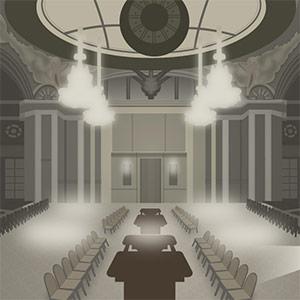Everybody’s heard of the conspiracy that casinos are designed with no windows or clocks so gamblers will forget where they are and how long they’ve been dumping their life savings into the casino. But much more thought goes into the design, décor, and theme of a casino than you would think.
Sure, you could treat customers like insects trapped in a roach motel, but when they finally escape, how do you get them back? The top casino designers of today abandon the old school ‘casino maze of confusion’ model for a good old-fashioned, ‘feel good’ appeal to the senses. If gamblers feel comfortable, confident, and happy in a casino, they will return. And that’s the real goal of a casino’s décor design. The evolution of Las Vegas is a prime example of the casino aesthetic in constant motion.
The History of Casino Design

In the beginning, there was a desert. And Las Vegas was without form, and void, and darkness was upon the face of the Strip. In 1931 gambling became legal in Nevada, and the first crop of small casinos and motels bloomed in the desert. But these were little more than desert pit stops for road-weary travelers. It wasn’t until the first casino resorts opened that the Las Vegas Strip began to take shape.
Architect Wayne McAllister designed the first Las Vegas casino resort, El Rancho. He merged the sumptuous elements of his Tijuana resort Agua Caliente with the Old West motif. The result was a resort with a 50-foot neon windmill and a roadside swimming pool. The interior was decked out in cowhide and knotty pine, and the specialties were steaks and showgirls.
The Old West theme endured for a decade, and its elements still figure prominently in the Vegas aesthetic. But it wasn’t until the Flamingo opened in 1946 that we began to see a change in theme from the rustic to the luxurious. Art deco interiors painted in the exotic tropical pastel pink-and-green of Miami drew the high rollers and Hollywood socialites.
The Mob Enters Vegas
When mobster Bugsy Siegel took over the Flamingo, he began flying in his favorite celebrities for grand opening ceremonies and expansion celebrations. Soon other casino resorts opened, leading into a half-century competition of superlatives. The biggest, the tallest, the swankiest—all casinos fought to outdo each other and compete for new customers looking for novelty.
The main reason that Las Vegas has a reputation as a ‘build and destroy’ city is due to this competition. But it wasn’t until the boom era of the megaresort casino that the gaudy, outlandish themes played second fiddle to the casino gaming design. The shift from novelty to the science of numbers emerged.
The Science of Casino Design

Former gambling addict turned professor Bill Friedman studied over 80 Nevada casinos to come to his conclusion: “The only relevant considerations for casino design are these: What percentage of visitors gamble? What percentage return to gamble? Nothing else matters.”
Friedman’s conclusion sums up what is known as ‘gaming design,’ where casino design is created with one thing in mind: getting people to gamble. He measured the math, percentages, and statistics to draw his conclusions. All of the casinos he studied showed a similar style: low ceilings, and a confusing maze of slots leading on to more and more gambling possibilities.
This led to the careful placement of slots in long rows, starting from the doorway to the dance floors. All other considerations were secondary, including the hotel rooms, bathrooms, and dining halls. These ‘fluff and filler’ utilities were deliberately hard to find.
The lack of clocks may serve the notion that the casino wanted gamblers to forget time, but the lack of windows was not designed to confuse. Harsh desert sunlight streaming through windows creates glare on slot machine screens and card tables. So window plans fell out of the design sketches.
The Psychology of Casino Design

Early Vegas casino themes emphasized novelty, but they did have psychological effects too – either planned or accidental. One of the more obvious themes involved escape fantasy. With the advent of the Jet Age of the 1950s, Americans could escape to exotic locales easier and faster than ever before. But for those without the budget of the jet set, a tropical-themed casino like the Flamingo represented a cheap escape without the need for a passport or foreign currency.
Another form of escapism involved identity. Caesars Palace opened up the idea that a visitor could be the Caesar of his own little empire, and filled the casino with the lavish décor of Roman antiquity, along with the excess and decadence associated with that era. Casino employees dressed in togas and wore sandals to flesh out the imagery. In the early years of Caesars Palace, toga-wrapped hostesses would greet male visitors with a warm welcome to Caesars, following with “I am your slave.” After walking through a host of statues and columns, you can be entertained in the Colosseum and fed in the Bacchanal Buffet.
Additional exotic themes include the Arabian theme of the Aladdin and the Polynesian paradise of the Castaways. These types of themes promised escape to 1001 Arabian nights of pleasure or a tropical adventure for the everyday American.
After the megaresort boom of the 80s and 90s, most of the original casinos had been bought, destroyed, and rebuilt in a new style. But as the strict, cold, calculated décor centered on gaming design started growing old, gamblers and casino owners began missing the playground design days of old. Some owners even kept certain design elements of earlier casinos, or even recycled old casino lettering into wall and ceiling decorations.
The Game Changers
Casino mogul, Steve Wynn partnered with designer Roger Thomas to embark on a new era of casino construction and design. Simply building the tallest resort with the most rooms and the longest lines of slots no longer made sense. People won’t make bets if they feel trapped in a casino maze or overwhelmed with flashing lights and jangling bells.
“People take on the characteristics of a room,” Thomas explained. “They feel rich in a rich space. And who doesn’t want to feel rich?”
For the first time in decades, casino owners considered the open-space, lavishly-decorated playground design over the gaming design. The paradigm shifted to the resort experience rather than gambling alone. Steve Wynn built The Mirage in 1989, and incorporated gaming zones within a wider entertainment sphere. The tried-and-true tropical theme was extended to its maximum effect: see tropics and tigers, lakes and dolphins, and a giant faux volcano spewing smoke and sounds at regular intervals.
This wasn’t just another example of ‘more is better.’ The Mirage managed to capture the imagination of a new demographic: families. The adults could take the kids for a day in dolphin world, and later while away the evening at a swanky cocktail bar with a tropical theme. Guests could spend the entire day without spending a dime in the machines or at the tables.
A Shift in Casino Design
So the biggest shift in design came when casino owners realized that there was a whole new group of people who did not come to Vegas to gamble. Creating unique, exotic experiences became a new way to bring in the crowds. People began streaming into the themed casinos for the experience alone.
The Bellagio is one of the best examples of the new design aesthetic. Wide open spaces, high ceilings, and ultra-lavish décor rule the day. Massive crystal chandeliers and shiny marble accents evoke the lavish lifestyle of the rich and famous. And according to the experts, if a place makes you feel like a million, you might begin spending like a millionaire.
A Feast for the Senses

The playground design model doesn’t just rely on bubbling tidal pools and rumbling volcanoes. Experts have even given thought to please all of the senses, including the nose. Some casinos pump pleasing aromas into the gaming area. The scents were researched and tested on groups of people. The idea behind this ‘aromatherapy’ was to create an unidentifiable yet pleasing aroma. They didn’t want people to think of a rose or another floral scent. They wanted to create a mixture of aromas which put people into a positive mood.
When people are in a positive mood, they might be inclined to spend more. It doesn’t matter whether it is on the casino floor or in the fancy restaurant with the celebrity chef. In fact, a major part of the casino resort experience caters to the culinary arts. The average casino resort is home to hundreds of dining options in a variety of venues, from the classic buffets to eateries with international food options. There is literally something for everyone.
But perhaps the biggest part of the new casino resort experience in Vegas is the return to the emphasis on entertainment. In the heyday of the Strip, Elvis and the Rat Pack defined the Las Vegas experience. The lifestyle and party swagger of these legends contributed more to the image of Vegas than mere gambling halls ever did. A brief decline in the quality of Vegas entertainment occurred during recent decades. But this is changing to accommodate the needs of the new generation.
A New Generation of Gamblers
The new generation does not want to sit in front of slots for hours dumping dollars into the abyss. They want personally-tailored experiences which cannot be had elsewhere. The return of the Vegas artist residencies marks a return to what made Vegas legendary. Why would they pack themselves into a giant arena to watch the mega pop stars of today, when they can see Lady Gaga or Britney Spears in a lavish lounge with only a few thousand seats?
In Las Vegas and beyond, resort casinos around the world are changing the way they attract new and returning customers. By creating a holistic entertainment experience, the new casino resorts dazzle the senses and create a positive environment for maximum enjoyment. By design.




